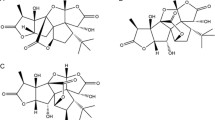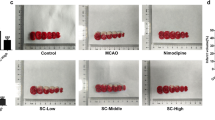Abstract
Cerebral ischemia/reperfusion injury plays an important role in the development of tissue injury after acute stroke, including neutrophils adhesion and infiltration, inflammation and oxidative stress. 10-O-(N,N-dimethylaminoethyl)-ginkgolide B methanesulfonate (XQ-1H) is a novel ginkdolide B derivative. In this study, we investigated the anti-inflammatory and anti-oxidative activities of XQ-1H in vivo and vitro. In our study, rats were treating with XQ-1H (31.2, 15.6 and 7.8 mg/kg) after middle cerebral artery occlusion surgery. Primary cultured cortical rat neurons were treated with Na2S2O4 for 1.5 h to mimic hypoxia and reoxygenation injury in vitro. Cortical neurons were preincubated with XQ-1H (100, 10, 1 μM) 24 h before hypoxic injury. Brain edema was evaluated by brain water content. Neutrophil infiltration was determined by fluorescence imaging method and myeloperoxidase assay. Intercellular adhesion molecule 1 (ICAM-1) and matrix metallopeptidase 9 (MMP-9) expressions were examined by immunohistochemistry analysis. Neuronal injury was assessed by 3-(4,5-dimethylthiazol-2-yl)-2,5-diphenyl-tetrazolium bromide, lactate dehydrogenase releasing and lactic acid content. The anti-oxidative effects of XQ-1H were evaluated by superoxide dismutase (SOD) activity and malondialdehyde content in ischemic brain and neuron cultures subjected to hypoxia/reoxygenation procedure. Results showed that XQ-1H reduced neutrophils infiltration to ischemic brain, which might result from down regulation of inflammatory mediators, such as ICAM-1 and MMP-9. In addition, an antioxidative effect of XQ-1H was observed in cortical neuron and brain homogenates by enhancing SOD activity and inhibiting lipid peroxidation. These results indicated that XQ-1H possessed a protective effect against cerebral ischemia, especially on neutrophil infiltration and oxidative stress.





Similar content being viewed by others
References
**ng C, Arai K, Lo EH, Hommel M (2012) Pathophysiologic cascades in ischemic stroke. Int J Stroke 7(5):378–385
Kamada H, Yu F, Nito C, Chan PH (2007) Influence of hyperglycemia on oxidative stress and matrix metalloproteinase-9 activation after focal cerebral ischemia/reperfusion in Rats: relation to blood-brain barrier dysfunction. Stroke 38(3):1044–1049
Ishikawa M, Cooper D, Russell J, Salter JW, Zhang JH, Nanda A, Granger DN (2003) Molecular determinants of the prothrombogenic and inflammatory phenotype assumed by the postischemic cerebral microcirculation. Stroke 34(7):1777–1782
Liu L, Kubes P (2003) Molecular mechanisms of leukocyte recruitment: organ-specific mechanisms of action. Thromb Haemost 89(2):213–220
Chou WH, Choi DS, Zhang H, Mu D, McMahon T, Kharazia VN, Lowell CA, Ferriero DM, Messing RO (2004) Neutrophil protein kinase Cdelta as a mediator of stroke reperfusion injury. J Clin Invest 114(1):49–56
Clark RK, Lee EV, Fish CJ, White RF, Price WJ, Jonak ZL, Feuerstein GZ, Barone FC (1993) Development of tissue damage, inflammation and resolution following stroke: an immunohistochemical and quantitative planimetric study. Brain Res Bull 31(5):565–572
Jordan JE, Zhao ZQ, Vinten-Johansen J (1999) The role of neutrophils in myocardial ischemia-reperfusion injury. Cardiovasc Res 43(4):860–878
Klebanoff SJ (1999) Myeloperoxidase. Proc Assoc Am Physicians 111(5):383–389
Bradley PP, Christensen RD, Rothstein G (1982) Cellular and extracellular myeloperoxidase in pyogenic inflammation. Blood 60(3):618–622
Jean WC, Spellman SR, Nussbaum ES, Low WC (1998) Reperfusion injury after focal cerebral ischemia: the role of inflammation and the therapeutic horizon. Neurosurgery 43(6):1382–1397
Gu Y, Zheng G, Xu M, Li Y, Chen X, Zhu W, Tong Y, Chung SK, Liu KJ, Shen J (2012) Caveolin-1 regulates nitric oxide-mediated matrix metalloproteinases activity and blood-brain barrier permeability in focal cerebral ischemia and reperfusion injury. J Neurochem 120(1):147–156
Li DD, Song JN, Huang H, Guo XY, An JY, Zhang M, Li Y, Sun P, Pang HG, Zhao YL, Wang JF (2013) The roles of MMP-9/TIMP-1 in cerebral edema following experimental acute cerebral infarction in rats. Neurosci Lett 550:168–172
Liu W, Li P, Feng F, Mao L (2010) Isolation and structure characterization of related impurities in 10-O-(N,N-dimethylaminoethyl)-ginkgolide B methanesulfonate (XQ-1H) bulk drug and quantitation by a validated RP-LC. J Pharm Biomed Anal 52(4):603–608
Deng Y, Fang W, Li Y, Cen J, Fang F, Lv P, Gong S, Mao L (2009) Blood-brain barrier breakdown by PAF and protection by XQ-1H due to antagonism of PAF effects. Eur J Pharmacol 616(1–3):43–47
Yang Q, Fang W, Lv P, Geng X, Li Y, Sha L (2012) Therapeutic neuroprotective effects of XQ-1H in a rat model of permanent focal cerebral ischemia. Pharmacology 89(1–2):1–6
Gamboa J, Blankenship DA, Niemi JP, Landreth GE, Karl M, Hilow E, Sundararajan S (2010) Extension of the neuroprotective time window for thiazolidinediones in ischemic stroke is dependent on time of reperfusion. Neuroscience 170(3):846–857
Longa EZ, Weinstein PR, Carlson S, Cummins R (1989) Reversible middle cerebral artery occlusion without craniectomy in rats. Stroke 20(1):84–91
Mdzinarishvili A, Kiewert C, Kumar V, Hillert M, Klein J (2007) Bilobalide prevents ischemia-induced edema formation in vitro and in vivo. Neuroscience 144(1):217–222
Lazarowski A, Caltana L, Merelli A, Rubio MD, Ramos AJ, Brusco A (2007) Neuronal mdr-1 gene expression after experimental focal hypoxia: a new obstacle for neuroprotection? J Neurol Sci 258(1–2):84–92
Qian Y, Guan T, Tang X, Huang L, Huang M, Li Y, Sun H (2011) Maslinic acid, a natural triterpenoid compound from Olea europaea, protects cortical neurons against oxygen-glucose deprivation-induced injury. Eur J Pharmacol 670(1):148–153
Barone FC, Hillegass LM, Tzimas MN, Schmidt DB, Foley JJ, White RF, Price WJ, Feuerstein GZ, Clark RK, Griswold DE et al (1995) Time-related changes in myeloperoxidase activity and leukotriene B4 receptor binding reflect leukocyte influx in cerebral focal stroke. Mol Chem Neuropathol 24(1):13–30
** R, Yang G, Li G (2010) Inflammatory mechanisms in ischemic stroke: role of inflammatory cells. J Leukoc Biol 87(5):779–789
Zhang RL, Chopp M, Jiang N, Tang WX, Prostak J, Manning AM, Anderson DC (1995) Anti-intercellular adhesion molecule-1 antibody reduces ischemic cell damage after transient but not permanent middle cerebral artery occlusion in the Wistar rat. Stroke 26(8):1438–1442
Zhang ZG, Chopp M, Tang WX, Jiang N, Zhang RL (1995) Postischemic treatment (2–4 h) with anti-CD11b and anti-CD18 monoclonal antibodies are neuroprotective after transient (2 h) focal cerebral ischemia in the rat. Brain Res 698(1–2):79–85
Rosell A, Cuadrado E, Ortega-Aznar A, Hernández-Guillamon M, Lo EH, Montaner J (2008) MMP-9-positive neutrophil infiltration is associated to blood-brain barrier breakdown and basal lamina type IV collagen degradation during hemorrhagic transformation after human ischemic stroke. Stroke 39(4):1121–1126
Tilling T, Korte D, Hoheisel D, Galla HJ (1998) Basement membrane proteins influence brain capillary endothelial barrier function in vitro. J Neurochem 71(3):1151–1157
Van den Steen PE, Dubois B, Nelissen I, Rudd PM, Dwek RA, Opdenakker G (2002) Biochemistry and molecular biology of gelatinase B or matrix metalloproteinase-9 (MMP-9). Crit Rev Biochem Mol Biol 37(6):375–536
Amantea D, Nappi G, Bernardi G, Bagetta G, Corasaniti MT (2009) Post-ischemic brain damage: pathophysiology and role of inflammatory mediators. FEBS J 276(1):13–26
Kriz J (2006) Inflammation in ischemic brain injury: timing is important. Crit Rev Neurobiol 18(1–2):145–157
Yilmaz G, Granger DN (2008) Cell adhesion molecules and ischemic stroke. Neurol Res 30(8):783–793
Sun J, Li Y, Fang W, Mao L (2011) Therapeutic time window for treatment of focal cerebral ischemia reperfusion injury with XQ-1 h in rats. Eur J Pharmacol 666(1–3):105–110
Acknowledgments
This study was supported by Natural Science Foundation of Jiangsu Province of China (Program No. BK2011625), National Natural Science Foundation of China (Program No. 81202974), Project Program of State Key Laboratory of Natural Medicines, China Pharmaceutical University (No. JKGQ201108), and sponsored by Qing Lan Project.
Author information
Authors and Affiliations
Corresponding author
Additional information
Jie Wei and Weirong Fang have contributed equally to this work.
Rights and permissions
About this article
Cite this article
Wei, J., Fang, W., Sha, L. et al. XQ-1H Suppresses Neutrophils Infiltration and Oxidative Stress Induced by Cerebral Ischemia Injury Both In Vivo and In Vitro. Neurochem Res 38, 2542–2549 (2013). https://doi.org/10.1007/s11064-013-1176-z
Received:
Revised:
Accepted:
Published:
Issue Date:
DOI: https://doi.org/10.1007/s11064-013-1176-z




